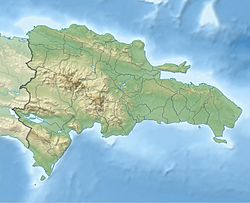Gaspar Hernández facts for kids
Quick facts for kids
Gaspar Hernández
|
|
|---|---|
 |
|
| Country | |
| Province | Espaillat |
| Municipality since | 1907 |
| Area | |
| • Total | 366.18 km2 (141.38 sq mi) |
| Elevation | 10 m (30 ft) |
| Population
(2012)
|
|
| • Total | 57,302 |
| • Density | 156.486/km2 (405.297/sq mi) |
| • Urban | 37,852 |
| Distance to – Moca |
64 km |
| Municipalities | 3 |
Gaspar Hernández is a small city located on the northern coast of the Dominican Republic. It's part of the Espaillat province.
It's a typical Dominican town. While tourism plays a small role, its main income comes from farming and raising animals. A famous baseball coach, Ramon Lora, was born here in 1977. He coached a college team in the USA that won a big championship in 2011. Many players on his team were from the Dominican Republic.
Contents
History of Gaspar Hernández
Long ago, the area where Gaspar Hernández is now was home to native people. These were mainly the Ciguayo and Ciboney tribes. They lived near rivers like the San Juan and in areas like Nagua and Samana.
The city we know today was officially started on April 5, 1907. It was first called Canto La Ermita. Most people lived near the Joba River back then. The name was changed to Gaspar Hernández to honor a famous priest. He was a friend of Juan Pablo Duarte, who helped the Dominican Republic gain independence from Haiti.
Weather in Gaspar Hernández
| Climate data for Gaspar Hernández (1961–1990) | |||||||||||||
|---|---|---|---|---|---|---|---|---|---|---|---|---|---|
| Month | Jan | Feb | Mar | Apr | May | Jun | Jul | Aug | Sep | Oct | Nov | Dec | Year |
| Record high °C (°F) | 34.0 (93.2) |
34.0 (93.2) |
35.8 (96.4) |
35.4 (95.7) |
37.8 (100.0) |
38.0 (100.4) |
36.6 (97.9) |
38.9 (102.0) |
37.0 (98.6) |
38.0 (100.4) |
38.7 (101.7) |
34.8 (94.6) |
38.9 (102.0) |
| Mean daily maximum °C (°F) | 27.4 (81.3) |
27.9 (82.2) |
28.7 (83.7) |
29.2 (84.6) |
30.6 (87.1) |
32.0 (89.6) |
31.7 (89.1) |
31.6 (88.9) |
31.6 (88.9) |
31.2 (88.2) |
29.2 (84.6) |
27.3 (81.1) |
29.9 (85.8) |
| Mean daily minimum °C (°F) | 18.9 (66.0) |
18.8 (65.8) |
19.4 (66.9) |
19.9 (67.8) |
20.9 (69.6) |
22.3 (72.1) |
22.3 (72.1) |
21.9 (71.4) |
21.8 (71.2) |
21.9 (71.4) |
20.6 (69.1) |
19.5 (67.1) |
20.7 (69.3) |
| Record low °C (°F) | 11.0 (51.8) |
12.0 (53.6) |
12.9 (55.2) |
14.8 (58.6) |
12.0 (53.6) |
18.0 (64.4) |
16.0 (60.8) |
11.0 (51.8) |
11.6 (52.9) |
18.0 (64.4) |
11.0 (51.8) |
11.0 (51.8) |
11.0 (51.8) |
| Average rainfall mm (inches) | 164.8 (6.49) |
130.3 (5.13) |
150.4 (5.92) |
192.2 (7.57) |
198.8 (7.83) |
106.9 (4.21) |
121.3 (4.78) |
129.0 (5.08) |
99.4 (3.91) |
159.2 (6.27) |
310.5 (12.22) |
273.2 (10.76) |
2,036 (80.16) |
| Average rainy days (≥ 1.0 mm) | 11.0 | 8.0 | 8.6 | 8.4 | 10.5 | 6.7 | 9.9 | 10.5 | 7.1 | 9.1 | 14.8 | 14.3 | 118.9 |
| Source: NOAA | |||||||||||||
Economy and Jobs
The economy of Gaspar Hernández is a mix of tourism and farming.
Ecotourism and Natural Beauty
Ecotourism is popular in the Ojo de Agua area. Here you can find cool caves and beautiful natural spots. There's also a special water source called Ojo de Agua, where water flows between rocks. Many hotels are located along the coast of Gaspar Hernández. Some of these include Bahia Principe and Bahia Esmeralda.
Farming and Animal Raising
The Veragua area is known for growing crops like bananas, corn, cassava, and sweet potatoes. Joba Arriba is a big producer of cocoa, which is used to make chocolate. It has one of the largest cocoa farmer groups in the country. Raising cattle and hogs is also a very important part of the economy.
Other Industries
Fishing has grown over time. The fish caught here are often sold to tourist resorts in nearby Sosua and Cabarete. Beekeeping is a newer activity in the area. People raise bees to produce honey, pollen, and royal jelly.
See also
 In Spanish: Gaspar Hernández para niños
In Spanish: Gaspar Hernández para niños


